平狄克微观经济学笔记 (5)
平狄克《微观经济学》第八版笔记

《微观经济学》知识点总结第一章绪论微观经济学研究个体经济单位的行为,包括消费者、工人、投资者、土地所有者、企业,事实上包括任何参与经济运行的个人和法人。
宏观经济学研究经济总量,诸如国民产出的水平和增长率、利率、失业以及通货膨胀。
微观经济学就是关于有限性的,研究如何配置稀缺资源。
重要概念包括权衡取舍,价格等。
微观经济学既关注实证问题,也关注规范问题.实证问题主要是解释和预测,而规范问题关注的是“应该如何”引号的问题。
独立的经济单位按功能可分为买者和卖者。
市场是买者和卖者的集合,通过他们实际或潜在的相互作用来决定一种或多种商品的价格.行业是指出售相同或紧密相关产品的厂商的集合。
套利是指在一个地方低价买进,然后在另一个地方高价卖出的行为。
完全竞争市场,即有许多买者和卖者的市场,没有任何买者和卖者能够影响价格。
卡特尔是指集体行动的生产者群体。
市场价格,竞争性市场中通行的价格。
市场范围,市场的边界,既包括地理的边界,又包括就产品范围而言的边界.名义价格,未经通货膨胀调整的绝对价格。
实际价格,一种按照总体价格指标衡量的价格,这是经过通胀调整后的价格。
消费者价格指数,CPI,衡量总体价格水平的指标。
生产者价格指数,PPI,衡量半成品和批发品的总体价格水平的指标。
第二章供给和需求的基本原理供给曲线,描绘生产者愿意出售的商品数量与该商品价格之间关系的曲线。
供给的变动表示供给曲线的移动,供给量的变动表示沿着供给曲线的移动。
需求曲线,消费者愿意购买的商品数量与该商品价格之间的关系。
需求的变动表示需求曲线的移动,需求量的变动表示沿着需求曲线的移动。
替代品,一种商品的价格上升会导致另一种商品的需求量增加的两种商品.互补品,一种商品的价格上升会导致另一种商品的需求量下降的两种商品。
均衡或市场出清价格,供给和需求相等时的价格。
市场机制,自由市场中价格不断变动直到市场出清的趋势.过剩,供给大于需求的情形。
短缺,需求量大于供给量的情形。
平狄克《微观经济学》第9版笔记和课后习题详解 第5章~第6章【圣才出品】
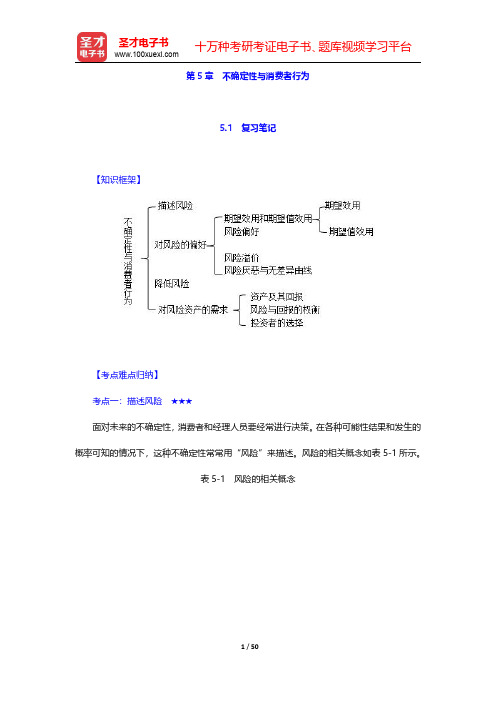
第5章不确定性与消费者行为5.1复习笔记【知识框架】【考点难点归纳】考点一:描述风险★★★面对未来的不确定性,消费者和经理人员要经常进行决策。
在各种可能性结果和发生的概率可知的情况下,这种不确定性常常用“风险”来描述。
风险的相关概念如表5-1所示。
表5-1风险的相关概念考点二:对风险的偏好★★★★★1.期望效用和期望值效用(1)期望效用的含义期望效用是各个可能结果相对应的效用的加权平均,其权数为各个结果发生的概率。
例如,可能结果为X1,X2(概率分别为Pr1,Pr2)的事件X的期望效用为E[u(X)]=Pr1u (X1)+Pr2u(X2)。
例如,图5-1中A点对应的效用即为期望效用。
(2)期望值效用的含义期望值效用是指不确定事件所有可能结果的加权平均(即期望值)给消费者带来的效用。
例如,可能结果为X1,X2(概率分别为Pr1,Pr2)的事件X的期望值效用为u[E(X)]=u (Pr1X1+Pr2X2)。
例如,图5-1中B点对应的效用即为期望值效用。
图5-1期望效用与期望值效用2.风险偏好风险偏好指人们对待风险的态度,描述人们在承担风险时对收益有怎样的要求。
在现实生活中,人们承担风险的意愿是不同的。
根据消费者期望效用与期望值效用的关系将其风险态度分为三种:风险厌恶、风险偏好和风险中性,如表5-2所示。
表5-2消费者风险态度分类图5-2风险态度3.风险溢价风险溢价指风险厌恶者为规避风险而愿付出的最大货币额。
通常来说,风险溢价的大小取决于其面临的风险性选择。
如图5-3所示,风险溢价CF表示一个人为了在风险性选项和确定性选项之间保持无差异而愿意放弃的收入额。
图5-3风险溢价4.风险厌恶与无差异曲线无差异曲线可以用于描述一个人对风险的厌恶程度,这样的无差异曲线描述了收入的期望值与收入的可变性即标准差间的关系。
消费者对于风险的无差异曲线都是向上倾斜的:因为风险令人厌恶,所以风险越大,就需要越高的期望收入来使人们保持相同的效用水平,如图5-4所示。
平狄克《微观经济学》(第8版)笔记和课后习题详解
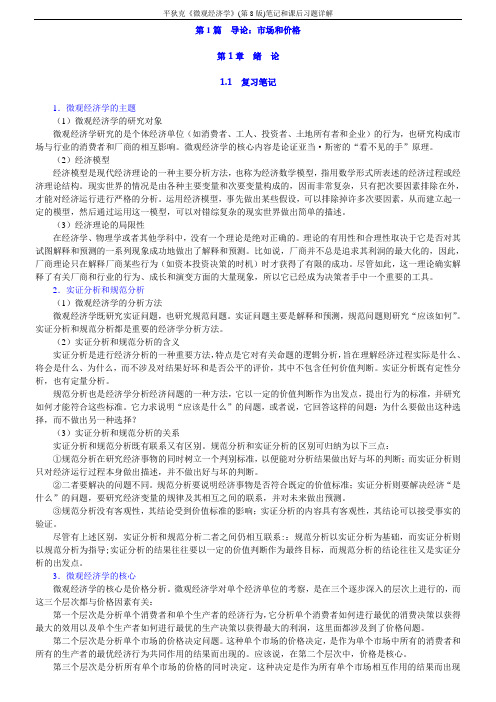
第1篇导论:市场和价格第1章绪论1.1复习笔记1.微观经济学的主题(1)微观经济学的研究对象微观经济学研究的是个体经济单位(如消费者、工人、投资者、土地所有者和企业)的行为,也研究构成市场与行业的消费者和厂商的相互影响。
微观经济学的核心内容是论证亚当·斯密的“看不见的手”原理。
(2)经济模型经济模型是现代经济理论的一种主要分析方法,也称为经济数学模型,指用数学形式所表述的经济过程或经济理论结构。
现实世界的情况是由各种主要变量和次要变量构成的,因而非常复杂,只有把次要因素排除在外,才能对经济运行进行严格的分析。
运用经济模型,事先做出某些假设,可以排除掉许多次要因素,从而建立起一定的模型,然后通过运用这一模型,可以对错综复杂的现实世界做出简单的描述。
(3)经济理论的局限性在经济学、物理学或者其他学科中,没有一个理论是绝对正确的。
理论的有用性和合理性取决于它是否对其试图解释和预测的一系列现象成功地做出了解释和预测。
比如说,厂商并不总是追求其利润的最大化的,因此,厂商理论只在解释厂商某些行为(如资本投资决策的时机)时才获得了有限的成功。
尽管如此,这一理论确实解释了有关厂商和行业的行为、成长和演变方面的大量现象,所以它已经成为决策者手中一个重要的工具。
2.实证分析和规范分析(1)微观经济学的分析方法微观经济学既研究实证问题,也研究规范问题。
实证问题主要是解释和预测,规范问题则研究“应该如何”。
实证分析和规范分析都是重要的经济学分析方法。
(2)实证分析和规范分析的含义实证分析是进行经济分析的一种重要方法,特点是它对有关命题的逻辑分析,旨在理解经济过程实际是什么、将会是什么、为什么,而不涉及对结果好坏和是否公平的评价,其中不包含任何价值判断。
实证分析既有定性分析,也有定量分析。
规范分析也是经济学分析经济问题的一种方法,它以一定的价值判断作为出发点,提出行为的标准,并研究如何才能符合这些标准。
它力求说明“应该是什么”的问题,或者说,它回答这样的问题:为什么要做出这种选择,而不做出另一种选择?(3)实证分析和规范分析的关系实证分析和规范分析既有联系又有区别。
平狄克微观经济学第九本课后习题答案笔记

平狄克微观经济学第九版课后习题答案与笔记内容简介本书遵循平狄克《微观经济学》(第9版)教材的章⽬目编排,共分4篇19章,每章由三部分组成:第⼀一部分为复习笔记,总结本章的重难点内容;第⼆二部分为课(章)后复习题详解,对第9版的所有课(章)后复习题都进⾏行行了了详细的分析和解答;第三部分为课(章)后练习题详解,对第9版的所有课(章)后练习题都进⾏行行了了详细的分析和解答。
作为该教材的学习辅导书,本书具有以下⼏几个⽅方⾯面的特点:(1)整理理名校笔记,浓缩内容精华。
每章的复习笔记以平狄克所著的《微观经济学》(第9版)为主,并结合国内外其他微观经济学经典教材对各章的重难点进⾏行行了了整理理,因此,本书的内容⼏几乎浓缩了了经典教材的知识精华。
(2)解析课后习题,提供详尽答案。
本书参考⼤大量量经济学相关资料料对平狄克所著的《微观经济学》(第9版)的课(章)后习题进⾏行行了了详细的分析和解答,并对相关重要知识点进⾏行行了了延伸和归纳。
(3)补充相关要点,强化专业知识。
⼀一般来说,国外英⽂文教材的中译本不不太符合中国学⽣生的思维习惯,有些语⾔言的表述不不清或条理理性不不强⽽而给学习带来了了不不便便,因此,对每章复习笔记的⼀一些重要知识点和⼀一些习题的解答,我们在不不违背原书原意的基础上结合其他相关经典教材进⾏行行了了必要的整理理和分析。
⽬目录第1篇 导论:市场与价格 第1章 绪 论 1.1 复习笔记 1.2 课后复习题详解 1.3 课后练习题详解 第2章 供给与需求的基本原理 2.1 复习笔记 2.2 课后复习题详解 2.3 课后练习题详解第2篇 ⽣产者、消费者与竞争性市场 第3章 消费者⾏为 3.1 复习笔记 3.2 课后复习题详解 3.3 课后练习题详解 第4章 个⼈需求与市场需求 4.1 复习笔记 4.2 课后复习题详解 4.3 课后练习题详解 第4章附录 需求理论:⼀种数学的处理⽅法 第5章 不确定性与消费者⾏为 5.1 复习笔记 5.2 课后复习题详解 5.3 课后练习题详解 第6章 ⽣ 产 6.1 复习笔记 6.2 课后复习题详解 6.3 课后练习题详解 第7章 ⽣产成本 7.1 复习笔记 7.2 课后复习题详解 7.3 课后练习题详解 第7章附录 ⽣产与成本理论:⼀种数学的处理⽅法 第8章 利润最⼤化与竞争性供给 8.1 复习笔记 8.2 课后复习题详解 第9章 竞争性市场分析 9.1 复习笔记 9.2 课后复习题详解 9.3 课后练习题详解第3篇 市场结构与竞争策略 第10章 市场势⼒:垄断与买⽅垄断 10.1 复习笔记 10.2 课后复习题详解 10.3 课后练习题详解 第11章 有市场势⼒的定价 11.1 复习笔记 11.2 课后复习题详解 11.3 课后练习题详解 第11章附录 纵向联合⼚商 第12章 垄断竞争与寡头垄断 12.1 复习笔记 12.2 课后复习题详解 12.3 课后练习题详解 第13章 博弈论与竞争策略 13.1 复习笔记 13.2 课后复习题详解 13.3 课后练习题详解 第14章 投⼊要素市场 14.1 复习笔记 14.2 课后复习题详解 14.3 课后练习题详解 第15章 投资、时间与资本市场 15.1 复习笔记 15.2 课后复习题详解第4篇 信息、市场失灵与政府的⾓⾊ 第16章 ⼀般均衡与经济效率 16.1 复习笔记 16.2 课后复习题详解 16.3 课后练习题详解 第17章 信息不对称的市场 17.1 复习笔记 17.2 课后复习题详解 17.3 课后练习题详解 第18章 外部性与公共物品 18.1 复习笔记 18.2 课后复习题详解 18.3 课后练习题详解 第19章 ⾏为经济学 19.1 复习笔记 19.2 课后复习题详解 19.3 课后练习题详解附录 指定平狄克《微观经济学》教材为考研参考书⽬目的院校列列表1.2. 课后习题详解1 ⼈人们常说,⼀一个好的理理论是可以⽤用实证的、数据导向的研究来加以证伪的。
《微观经济学》平狄克教材
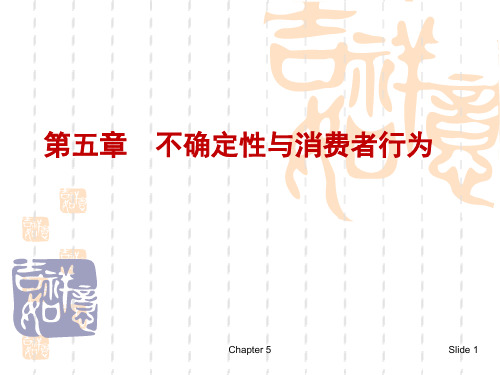
而获得两端收入的可能性小。
Chapter 5
Slide 19
不同概率分布的情形
概率
与工作2相比,工作1的收入 分布较离散,标准差也更大。
0.2
工作2
0.1
工作1
$1000
$1500
Chapter 5
$2000
收入
Slide 20
5.1 风险描述
决策(Decision making)
人们对待风险的态度会影响他们的决策。
Chapter 5
Slide 9
5.1 风险描述
假设Pr1,Pr2…… ,Pr n分别表示每一种可能性
结果的概率,而X1,X2……,X n分别代表每一 种可能性结果的值,那么,期望值的公式为:
E(X) Pr1X1 Pr2 X 2 ... Prn X n
Chapter 5
Slide 10
A
6
0
10
20
Chapter 5
30
收入
Slide 28
5.2 风险的偏好
风险爱好者
如果消费者在期望收入相同的确定性工作与 不确定性工作中选择了后者,那么,该消费 者就是风险爱好者(risk loving)。
例如:赌博、一些犯罪活动
Chapter 5
Slide 29
5.2 风险的偏好
风险爱好者
2 9,900 2 99.50
Slide 15
5.1 风险描述
计算方差
结果1 结果 2 方差 标准差
工作1 工作2
2,000 1,510
1,000 510
250,000 9,900
500.00 99.50
平狄克鲁宾费尔德微观经济学笔记
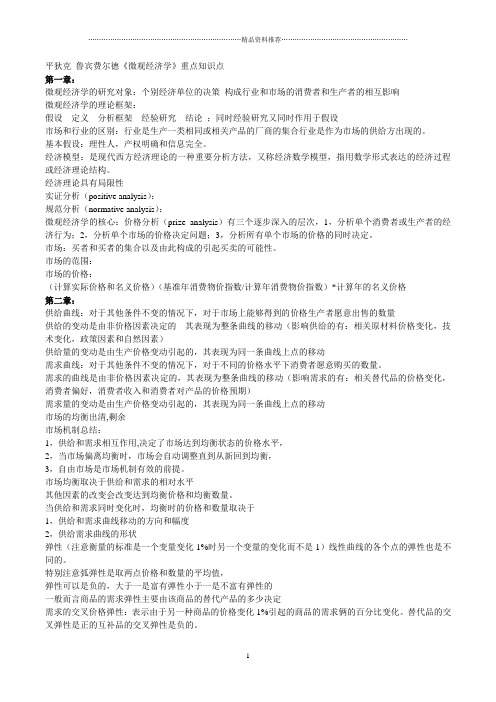
平狄克鲁宾费尔德《微观经济学》重点知识点第一章:微观经济学的研究对象:个别经济单位的决策构成行业和市场的消费者和生产者的相互影响微观经济学的理论框架:假设定义分析框架经验研究结论;同时经验研究又同时作用于假设市场和行业的区别:行业是生产一类相同或相关产品的厂商的集合行业是作为市场的供给方出现的。
基本假设:理性人,产权明确和信息完全。
经济模型:是现代西方经济理论的一种重要分析方法,又称经济数学模型,指用数学形式表达的经济过程或经济理论结构。
经济理论具有局限性实证分析(positive analysis):规范分析(normative analysis):微观经济学的核心:价格分析(prize analysis)有三个逐步深入的层次,1,分析单个消费者或生产者的经济行为;2,分析单个市场的价格决定问题;3,分析所有单个市场的价格的同时决定。
市场:买者和买者的集合以及由此构成的引起买卖的可能性。
市场的范围:市场的价格:(计算实际价格和名义价格)(基准年消费物价指数/计算年消费物价指数)*计算年的名义价格第二章:供给曲线:对于其他条件不变的情况下,对于市场上能够得到的价格生产者愿意出售的数量供给的变动是由非价格因素决定的其表现为整条曲线的移动(影响供给的有:相关原材料价格变化,技术变化,政策因素和自然因素)供给量的变动是由生产价格变动引起的,其表现为同一条曲线上点的移动需求曲线:对于其他条件不变的情况下,对于不同的价格水平下消费者愿意购买的数量。
需求的曲线是由非价格因素决定的,其表现为整条曲线的移动(影响需求的有:相关替代品的价格变化,消费者偏好,消费者收入和消费者对产品的价格预期)需求量的变动是由生产价格变动引起的,其表现为同一条曲线上点的移动市场的均衡出清,剩余市场机制总结:1,供给和需求相互作用,决定了市场达到均衡状态的价格水平,2,当市场偏离均衡时,市场会自动调整直到从新回到均衡,3,自由市场是市场机制有效的前提。
平狄克《微观经济学》(第7版)习题详解(第5章-不确定性与消费者行为)
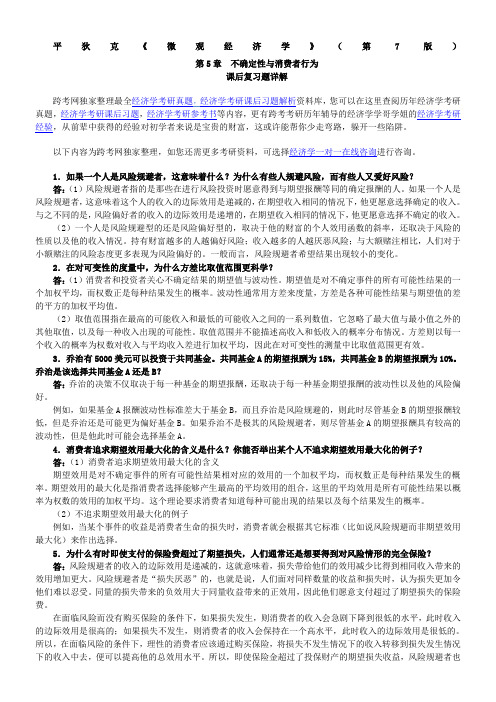
平狄克《微观经济学》(第7版)第5章不确定性与消费者行为课后复习题详解跨考网独家整理最全经济学考研真题,经济学考研课后习题解析资料库,您可以在这里查阅历年经济学考研真题,经济学考研课后习题,经济学考研参考书等内容,更有跨考考研历年辅导的经济学学哥学姐的经济学考研经验,从前辈中获得的经验对初学者来说是宝贵的财富,这或许能帮你少走弯路,躲开一些陷阱。
以下内容为跨考网独家整理,如您还需更多考研资料,可选择经济学一对一在线咨询进行咨询。
1.如果一个人是风险规避者,这意味着什么?为什么有些人规避风险,而有些人又爱好风险?答:(1)风险规避者指的是那些在进行风险投资时愿意得到与期望报酬等同的确定报酬的人。
如果一个人是风险规避者,这意味着这个人的收入的边际效用是递减的,在期望收入相同的情况下,他更愿意选择确定的收入。
与之不同的是,风险偏好者的收入的边际效用是递增的,在期望收入相同的情况下,他更愿意选择不确定的收入。
(2)一个人是风险规避型的还是风险偏好型的,取决于他的财富的个人效用函数的斜率,还取决于风险的性质以及他的收入情况。
持有财富越多的人越偏好风险;收入越多的人越厌恶风险;与大额赌注相比,人们对于小额赌注的风险态度更多表现为风险偏好的。
一般而言,风险规避者希望结果出现较小的变化。
2.在对可变性的度量中,为什么方差比取值范围更科学?答:(1)消费者和投资者关心不确定结果的期望值与波动性。
期望值是对不确定事件的所有可能性结果的一个加权平均,而权数正是每种结果发生的概率。
波动性通常用方差来度量,方差是各种可能性结果与期望值的差的平方的加权平均值。
(2)取值范围指在最高的可能收入和最低的可能收入之间的一系列数值,它忽略了最大值与最小值之外的其他取值,以及每一种收入出现的可能性。
取值范围并不能描述高收入和低收入的概率分布情况。
方差则以每一个收入的概率为权数对收入与平均收入差进行加权平均,因此在对可变性的测量中比取值范围更有效。
微观经济学总结平狄克
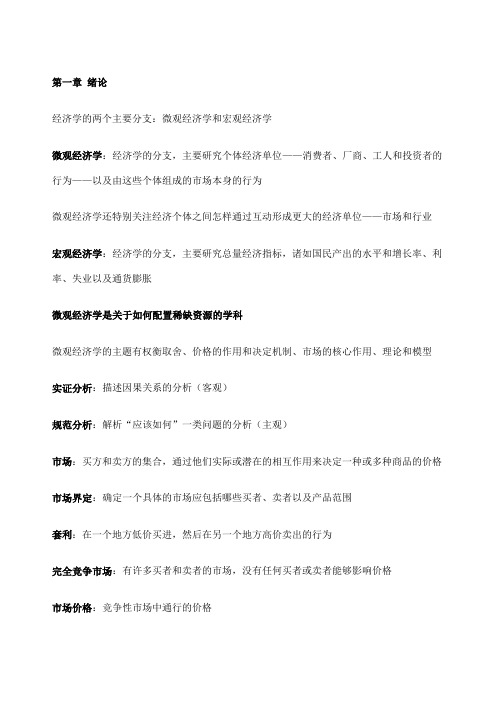
第一章绪论经济学的两个主要分支:微观经济学和宏观经济学微观经济学:经济学的分支,主要研究个体经济单位——消费者、厂商、工人和投资者的行为——以及由这些个体组成的市场本身的行为微观经济学还特别关注经济个体之间怎样通过互动形成更大的经济单位——市场和行业宏观经济学:经济学的分支,主要研究总量经济指标,诸如国民产出的水平和增长率、利率、失业以及通货膨胀微观经济学是关于如何配置稀缺资源的学科微观经济学的主题有权衡取舍、价格的作用和决定机制、市场的核心作用、理论和模型实证分析:描述因果关系的分析(客观)规范分析:解析“应该如何”一类问题的分析(主观)市场:买方和卖方的集合,通过他们实际或潜在的相互作用来决定一种或多种商品的价格市场界定:确定一个具体的市场应包括哪些买者、卖者以及产品范围套利:在一个地方低价买进,然后在另一个地方高价卖出的行为完全竞争市场:有许多买者和卖者的市场,没有任何买者或卖者能够影响价格市场价格:竞争性市场中通行的价格市场范围:市场的边界,既包括地理的边界,又包括就产品范围而言的边界名义价格:未经通货膨胀调整的绝对价格实际价格:一种按照总体价格指标衡量的价格,就是通过膨胀调整后的价格实际分析中,我们应该利用消费者价格指数或生产者价格指数把名义价格转换成实际价格消费者价格指数(Consumer Price Index, CPI):衡量总体价格水平的指标生产者价格指数(Producer Price Index, PPI):衡量半成品和批发品的总体价格水平的指标实际价格=CCC膨胀前膨胀后×名义价格章节练习:1、人们常说,一个好的理论是可以用实证的、数据导向的研究来加以证伪的。
试解释为什么一个不能用经验事实来验证的理论不是一个好理论。
2、下面两个陈述哪个是实证分析,哪个是规范分析?这两类分析有什么不同?A、汽油配给制(为个人每年购买的汽油量设置一个最大限额)是一个糟糕的社会政策,因为它阻碍了竞争性市场体系的运转。
平狄克《微观经济学》第八版笔记
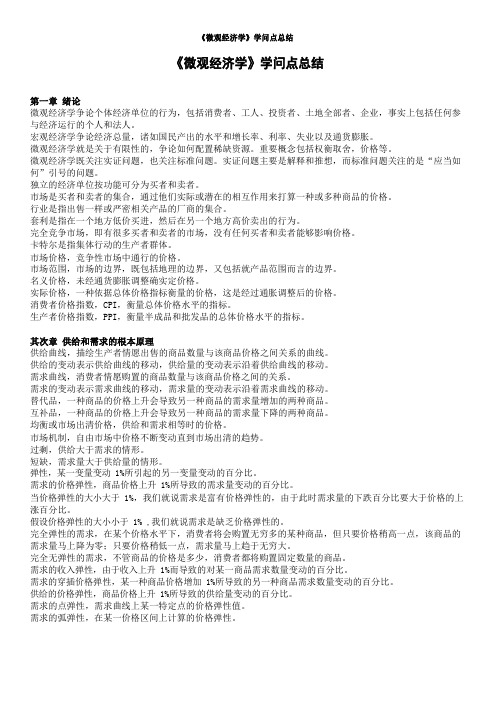
《微观经济学》学问点总结第一章绪论微观经济学争论个体经济单位的行为,包括消费者、工人、投资者、土地全部者、企业,事实上包括任何参与经济运行的个人和法人。
宏观经济学争论经济总量,诸如国民产出的水平和增长率、利率、失业以及通货膨胀。
微观经济学就是关于有限性的,争论如何配置稀缺资源。
重要概念包括权衡取舍,价格等。
微观经济学既关注实证问题,也关注标准问题。
实证问题主要是解释和推想,而标准问题关注的是“应当如何”引号的问题。
独立的经济单位按功能可分为买者和卖者。
市场是买者和卖者的集合,通过他们实际或潜在的相互作用来打算一种或多种商品的价格。
行业是指出售一样或严密相关产品的厂商的集合。
套利是指在一个地方低价买进,然后在另一个地方高价卖出的行为。
完全竞争市场,即有很多买者和卖者的市场,没有任何买者和卖者能够影响价格。
卡特尔是指集体行动的生产者群体。
市场价格,竞争性市场中通行的价格。
市场范围,市场的边界,既包括地理的边界,又包括就产品范围而言的边界。
名义价格,未经通货膨胀调整确实定价格。
实际价格,一种依据总体价格指标衡量的价格,这是经过通胀调整后的价格。
消费者价格指数,CPI,衡量总体价格水平的指标。
生产者价格指数,PPI,衡量半成品和批发品的总体价格水平的指标。
其次章供给和需求的根本原理供给曲线,描绘生产者情愿出售的商品数量与该商品价格之间关系的曲线。
供给的变动表示供给曲线的移动,供给量的变动表示沿着供给曲线的移动。
需求曲线,消费者情愿购置的商品数量与该商品价格之间的关系。
需求的变动表示需求曲线的移动,需求量的变动表示沿着需求曲线的移动。
替代品,一种商品的价格上升会导致另一种商品的需求量增加的两种商品。
互补品,一种商品的价格上升会导致另一种商品的需求量下降的两种商品。
均衡或市场出清价格,供给和需求相等时的价格。
市场机制,自由市场中价格不断变动直到市场出清的趋势。
过剩,供给大于需求的情形。
短缺,需求量大于供给量的情形。
平狄克:微观经济学5 elasticity

0
50
100
Quantity
2. . . . leads to a 67% decrease in quantity demanded.
Figure 1 The Price Elasticity of Demand
(e) Perfectly Elastic Demand: Elasticity Equals Infinity
Percentage change in quantity demanded Percentage change in price
Price elasticity of demand =
Copyright © 2004 South-Western/Thomson Learning
Computing the Price Elasticity of Demand
(Q2 Q1 ) / [(Q2 Q1 ) / 2] Price elasticity of demand = (P2 P1 ) / [(P2 P1 ) / 2]
Copyright © 2004 South-Western/Thomson Learning
The Midpoint Method: A Better Way to Calculate Percentage Changes and Elasticities • Example: If the price of an ice cream cone increases from $2.00 to $2.20 and the amount you buy falls from 10 to 8 cones, then your elasticity of demand, using the midpoint formula, would be calculated as: (10 8) 22% (10 8) / 2 2.32 (2.20 2.00) 9.5% (2.00 2.20) / 2
平狄克微观经济学知识点
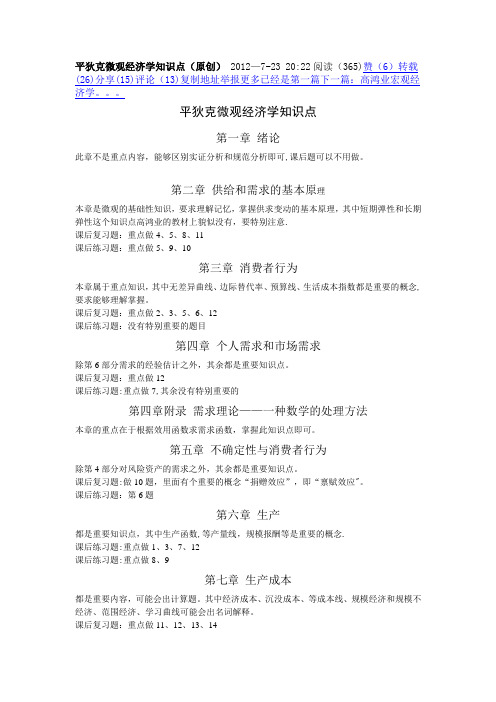
平狄克微观经济学知识点(原创)2012—7-23 20:22阅读(365)赞(6)转载(26)分享(15)评论(13)复制地址举报更多已经是第一篇下一篇:高鸿业宏观经济学。
平狄克微观经济学知识点第一章绪论此章不是重点内容,能够区别实证分析和规范分析即可,课后题可以不用做。
第二章供给和需求的基本原理本章是微观的基础性知识,要求理解记忆,掌握供求变动的基本原理,其中短期弹性和长期弹性这个知识点高鸿业的教材上貌似没有,要特别注意.课后复习题:重点做4、5、8、11课后练习题:重点做5、9、10第三章消费者行为本章属于重点知识,其中无差异曲线、边际替代率、预算线、生活成本指数都是重要的概念,要求能够理解掌握。
课后复习题:重点做2、3、5、6、12课后练习题:没有特别重要的题目第四章个人需求和市场需求除第6部分需求的经验估计之外,其余都是重要知识点。
课后复习题:重点做12课后练习题:重点做7,其余没有特别重要的第四章附录需求理论——一种数学的处理方法本章的重点在于根据效用函数求需求函数,掌握此知识点即可。
第五章不确定性与消费者行为除第4部分对风险资产的需求之外,其余都是重要知识点。
课后复习题:做10题,里面有个重要的概念“捐赠效应”,即“禀赋效应"。
课后练习题:第6题第六章生产都是重要知识点,其中生产函数,等产量线,规模报酬等是重要的概念.课后练习题:重点做1、3、7、12课后练习题:重点做8、9第七章生产成本都是重要内容,可能会出计算题。
其中经济成本、沉没成本、等成本线、规模经济和规模不经济、范围经济、学习曲线可能会出名词解释。
课后复习题:重点做11、12、13、14课后练习题:重点做8、9、11、12、13第七章附录生产和成本理论——一个数学的处理课后题1、2、3可以做做,不难。
第八章利润的最大化和竞争性供给是重点章节,完全竞争市场可能会出计算,生产者剩余、行业的长期供给曲线可能会出名词解释.课后复习题:1、2、3、4、5、10课后练习题:4、5、10、11第九章竞争性市场分析本章是核心知识点,几种模型的福利变化分析,包括图形、原理等必须理解、熟记.很可能会出大题或者是计算题,要能够计算福利变化。
平狄克微观经济学笔记(5)

平狄克微观经济学笔记(5)CHAPTER 6PRODUCTIONTEACHING NOTESChapter 6 is the first of the three chapters that present the basic theory of supply. It may be beneficial to first review, or summarize, the derivation of demand and present an overview of the theory of competitive supply. The review can be beneficial given the similarities between the theory of demand and the theory of supply. Students often find that the theory of supply is easier to understand because it is less abstract, and the concepts are more familiar. This in turn can improve the students’ understanding of the theory of demand when they go back and review it again.In this chapter it is important to take the time to carefully go through the definitions, as this will be the foundation for what is done in the next two chapters. While the concept of a production function is not difficult, the mathematical and graphical representation can sometimes be confusing. It helps to take the time to do as many examples as you have time for. When describing and graphing the production function with output on the vertical axis and one input on the horizontal axis, point out that the production function is the equation for the boundary of the production set, and hence defines the highest level of output for any given level of inputs. Technical efficiency is assumed throughout the discussion of the theory of supply. At any time you can introduce a discussion of the importance of improving productivity and the concept of learning by doing. Examples 1 and 2 in the text are also good for discussion.Graphing the production function leads naturally to a discussion of marginal product and diminishing returns. Emphasize that diminishing returns exist because some factors are fixed by definition, and that diminishing returns does not mean negative returns. If you have not discussed marginal utility, now is the time to make sure that the student knows the difference between average and marginal. An example that captures students’ attention is the relationship between average a nd marginal test scores. If their latest mid-term grade is greater than their average grade to date, this will increase their average.Isoquants are defined and discussed in section 6.3 of the chapter. Rely on the students’ understanding of indifference curves when discussing isoquants, and point out that as with indifference curves, isoquants are a two-dimensional representation of a three-dimensional production function. Key concepts in this section of the chapter are the marginal rate of technical substitution and returns to scale. Do as many concrete examples as you have time for to help explain these two important concepts. Examples 6.3 and 6.4 help to give concrete meaning to MRTS and returns to scale. Section 6.4 discusses returns to scale.QUESTIONS FOR REVIEW1. What is a production function? How does a long-run production function differ from a short-run production function?A production function represents how inputs are transformed into outputs by a firm.We focus on the firm with one output and aggregate all inputs or factors of productioninto one of several categories, such as labor, capital, and materials. In the short run,one or more factors of production cannot be changed. As time goes by, the firm has theopportunity to change the levels of all inputs. In the long-run production function, allinputs are variable.2. Why is the marginal product of labor likely to increase initially in the short run as more of the variable input is hired?The marginal product of labor is likely to increase initially because when there aremore workers, each is able to specialize on an aspect of the production process inwhich he or she is particularly skilled. For example, think of the typical fast foodrestaurant. If there is only one worker, he will need to prepare the burgers, fries,and sodas, as well as take the orders. Only so many customers can be served in anhour. With two or three workers, each is able to specialize and the marginal product(number of customers served per hour) is likely to increase as we move from one totwo to three workers. Eventually, there will be enough workers and there will be nomore gains from specialization. At this point, the marginal product will diminish.3. Why does production eventually experience diminishing marginal returns to labor in the short run?The marginal product of labor will eventually diminish because there will be at leastone fixed factor of production, such as capital. With capital fixed, the workplace willeventually become so congested, that the productivity of additional workers willdecline. Also, with capital fixed, as more workers are added, they will need to sharethe fixed capital, which will eventually cause the marginal product of labor todiminish as the capital is spread across too many workers. Think for example of anoffice where there are only three computers. As more and more employees mustshare the computers, the marginal product of each additional employee will diminish.4. You are an employer seeking to fill a vacant position on an assembly line. Are you more concerned with the average product of labor or the marginal product of labor for the last person hired? If you observe that your average product is just beginning to decline, should you hire any more workers? What does this situation imply about the marginal product of your last worker hired?In filling a vacant position, you should be concerned with the marginal product of thelast worker hired because the marginal product measures the effect on output, or totalproduct, of hiring another worker. This in turn will help to determine the revenuegenerated by hiring another worker, which can then be compared to the cost of hiringanother worker.The point at which the average product begins to decline is the point where averageproduct is equal to marginal product. When average product declines, the marginalproduct of the last worker hired is lower than the average product of previously hiredworkers.Although adding more workers results in a further decline in average product, totalproduct continues to increase, so it may still be advantageous to hire another worker.5. What is the difference between a production function and an isoquant?A production function describes the maximum output that can be achieved with anygiven combination of inputs. An isoquant identifies all of the different combinationsof the inputs that can be used to produce one particular level of output.6. Faced with constantly changing conditions, why would a firm ever keep any factors fixed? What criteria determine whethera factor is fixed or variable?Whether a factor is fixed or variable depends on the time horizon in consideration: allfactors are fixed in the very short run; all factors are variable in the long run. Asstated in the text: “All fixed inputs in the short run represent outcomes of previouslong-run decisions based on firms’ estimates of what they could profitably produce andsell.” Some factors are fixed in the short run, whether the firm likes it or not, simplybecause it takes time to adjust the level of the variables. For example, the firm may belegally bound by a lease on a building, some employees may have contracts that mustbe upheld, or construction of a new facility may take some number of months. Recallthat the short run is not defined as a specific number of months or years, but as thatperiod of time where some inputs cannot be changed for reasons such as those givenabove.7. Isoquants can be convex, linear, or L-shaped. What does each of these shapes tell you about the nature of the production function? What does each of these shapes tell you about the MRTS?Convex isoquants imply that within some range, some number of units of one inputcan be substituted for a unit of the other input, and output can be maintained at thesame level. In this case, the MRTS is diminishing as we move down along theisoquant. Linear isoquants imply that the slope, or the MRTS, is constant. Thismeans that the same number of units of one input can always be exchanged for a unitof the other input and output can be maintained. The inputs are perfect substitutes.L-shaped isoquants imply that the inputs are perfect complements, or that the firm isproducing under a fixed proportions type of technology. In this case the firm cannotgive up one input in exchange for the other and still maintain the same level ofoutput. For example, the firm may require exactly 4 units of capital for each unit oflabor, in which case one input cannot be substituted for the other.8. Can an isoquant ever slope upwards? Explain.No. This would mean that if you increased both inputs then output would stay thesame. As a general rule, if the firm has more of all the inputs they can produce moreoutput.9. Explain the term “marginal rate of technical substitution”? What does a MRTS=4 mean?MRTS is the amount by which the quantity of one input can be reduced when theother input is increased by one unit, while maintaining the same level of output. Ifthe MRTS is 4 then the one input can be reduced by 4 units as the other is increasedby one unit and output will be the same.10. Explain why the marginal rate of technical substitution is likely to diminish as more and more labor is substituted for capital.As the quantities of the inputs are changed the marginal product of each input willchange. As more and more labor is added, the marginal product of labor is likely todiminish. Because capital has been reduced, each unit of capital remaining is likelyto be more productive. Therefore, more units of labor will be required to replace eachunit of capital. Alternatively, as we move down and to the right along an isoquantalong which the MRTS is diminishing, we have to give up less capital for each unit oflabor added to keep output constant.11. Diminishing returns to a single factor of production and constant returns to scale are not inconsistent. Discuss. Diminishing returns to a single factor are observable in all production processes atsome level of inputs. This fact is so pervasive that economists have named it the “lawof diminishing marginal productivity.” By definition, the marginal product of an inputis the additional output generated by employing one more unit of the input, all otherinputs held fixed. The extra output, or returns, to the single input diminish because allother inputs are held fixed. For example, when holding the level of capital constant,each additional unit of labor has less capital to work with.Unlike the returns to a single factor, returns to scale are proportional increases in allinputs. While each factor by itself exhibits diminishing returns, output may more thandouble, less than double, or exactly double when all the inputs are doubled. Thedistinction again is that with returns to scale, all inputs are increased in the sameproportion and no input is held fixed.12. Can a firm have a production function that exhibits increasing returns to scale, constant returns to scale, and decreasing returns to scale as output increases? Discuss.Most firms have production functions that exhibit first increasing, then constant, andultimately decreasing returns to scale. At low levels of output, a proportional increasein all inputs may lead to a larger-than-proportional increase in output, based on anincrease in the opportunity for each factor to specialize. For example, if there are nowtwo people and two computers, each person can specialize by completing those tasksthat they are best at, which allows output to more than double. As the firm grows, theopportunities for specialization may diminish and a doubling of all inputs will lead toonly a doubling of output. When there are constant returns to scale, the firm isreplicating what it is already doing. At some level of production, the firm will be solarge that when inputs are doubled, output will less than double, a situation that canarise from management diseconomies.13. Give an example of a production process in which the short run involves a day or a week and the long run any period longer than a week.Any small business where one input requires more than a week to change would be anexample. The process of hiring more labor, which requires announcing the positi on,interviewing applicants, and negotiating terms of employment, can take a day, if donethrough a temporary employment agency. Usually, however, the process takes a weekor more. Expansion, requiring a larger location, will also take longer than a week.EXERCISES1. The menu at Joe’s coffee shop consists of a variety of coffee drinks, pastries, and sandwiches. The marginal product of an additional worker can be defined as the number of customers that can be served by that worker in a given time period. Joe has been employing one worker, but is considering hiring a second and a third. Explain why the marginal product of the second and third workers might be higher than the first. Why might you expect the marginal product of additional workers to eventually diminish?The marginal product could well increase for the second and third workers, sinceeach of the first 2 or 3 workers would be able to specialize in a different task. If thereis only 1 worker, then that worker will have to take orders and prepare all the food.Eventually, however, the marginal product would diminish because there would betoo many people behind the counter trying to accomplish a limited number of tasks.2. Suppose a chair manufacturer is producing in the short run (with its existing plant and equipment). The manufacturer has observed the following levels of production corresponding to different numbers of workers:Number of chairs Number of workers1 102 183 244 285 306 28725a. Calculate the marginal and average product of labor for this production function.The average product of labor, AP L, is equal to QL. The marginal product of labor, MP L,is equal to ?QL, the change in output divided by the change in labor input. For thisproduction process we have:L Q AP L MP L0 0 __ __1 10 10 102 18 9 83 24 8 64 28 7 45 306 26 28 4.7 -27 25 3.6 -3b. Does this production function exhibit diminishing returns to labor? Explain.This production process exhibits diminishing returns to labor. The marginal product of labor, the extra output produced by each additional worker, diminishes as workers are added, and is actually negative for the sixth and seventh workers.c. Explain intuitively what might cause the marginal product of labor to become negative.Labor’s negative marginal product for L> 5 may arise from congestion in the chair manufacturer’s facto ry. Since more laborers are using the same, fixed amount of capital, it is possible that they could get in each other’s way, decreasing efficiency and the amount of output. Many firms also have to control the quality of output and the high congestion of labor may produce output that is not of a high enough quality to be offered for sale, which can contribute to a negative marginal product.3. Fill in the gaps in the table below.Quantity of Variable InputTotalOutputMarginal Productof Variable InputAverage Productof Variable Input0 0 ___ ___1 2252 3003 3004 11405 2256 225Quantity of Variable InputTotalOutputMarginal Productof Variable InputAverage Productof Variable Input0 0 ___ ___1 225 225 2252 600 375 3003 900 300 3004 1140 240 2855 1365 225 2736 1350 -15 2254. A political campaign manager has to decide whether to emphasize television advertisements or letters to potential voters in a reelection campaign. Describe the production function for campaign votes. How might information about this function (such as the shape of the isoquants) help the campaign manager to plan strategy?The output of concern to the campaign manager is the number of votes. Theproduction function uses two inputs, television advertising and direct mail. The use ofthese inputs requires knowledge of the substitution possibilities between them. If theinputs are perfect substitutes, the resultant isoquants are line segments, and thecampaign manager will use only one input based on the relative prices. If the inputsare not perfect substitutes, the isoquants will have a convex shape. The campaignmanager will then use a combination of the two inputs.5. For each of the following examples, draw a representative isoquant. What can you say about the marginal rate of technical substitution in each case?a. A firm can hire only full-time employees to produce its output, or it can hire somecombination of full-time and part-time employees. For each full-time worker let go, the firm must hire an increasing number of temporary employees to maintain the same level of output.Place part time workers on the vertical axis$ and full time workers on the$horizontal axis. The slope of the isoquant measures the number of part timeworkers that can be exchanged for a full time worker, while still maintaining output.When we are at the bottom end of the isoquant we have a lot of full time workers andfew part time workers. As we move up the isoquant and give up full time workers,we must hire more and more part time workers to replace each full time worker. Theslope increases (in absolute value terms) as we move up the isoquant. The isoquantis therefore convex and we have diminishing marginal rate of technical substitution.b. A firm finds they it can always trade two units of labor for one unit of capital andstill keep output constant.The marginal rate of technical substitution measures the number of units of laborthat can be exchanged for a unit of capital while still maintaining output. If the firmcan always trade two labor for one capital then the MRTS is constant and theisoquant is linear.c. A firm requires exactly two full-time workers to operate each piece of machineryin the factory.This firm operates under a fixed proportions technology, and the isoquants are L-shaped. The firm cannot exchange any labor for capital and still maintain outputbecause it must maintain a fixed 2:1 ratio of labor:capital.6. A firm has a production process in which the inputs to production are perfectly substitutable in the long run. Can you tell whether the marginal rate of technical substitution is high or low, or is further information necessary? Discuss.The marginal rate of technical substitution, MRTS, is the absolute value of the slope ofan isoquant. If the inputs are perfect substitutes, the isoquants will be linear. Tocalculate the slope of the isoquant, and hence the MRTS , we need to know the rate atwhich one input may be substituted for the other. In this case, we do not knowwhether the MRTS is high or low. All we know is that it is a constant number. Weneed to know the marginal product of each input to determine the MRTS.7. The marginal product of labor in the production of computer chips is 50 chips per hour. The marginal rate of technical substitution of hours of labor for hours of machine-capital is 1/4. What is the marginal product of capital?The marginal rate of technical substitution is defined at the ratio of the two marginalproducts. Here, we are given the marginal product of labor and the marginal rate oftechnical substitution. To determine the marginal product of capital, substitute thegiven values for the marginal product of labor and the marginal rate of technical substitution into the following formula:M P M P M R T S ,M P L K K== o r 5014, or MP K = 200 computer chips per hour.8. Do the following functions exhibit increasing, constant, or decreasing returns to scale? What happens to the marginal product of each individual factor as that factor is increased, and the other factor is held constant?a. q =3L +2KThis function exhibits constant returns to scale. For example, if L is 2 and K is 2then q is 10. If L is 4 and K is 4 then q is 20. When the inputs are doubled, outputwill double. Each marginal product is constant for this production function. When Lincreases by 1 q will increase by 3. When K increases by 1 q will increase by 2.b. q =(2L +2K )12This function exhibits decreasing returns to scale. For example, if L is 2 and K is 2then q is 2.8. If L is 4 and K is 4 then q is 4. When the inputs are doubled, outputwill less than double. The marginal product of each input is decreasing. This can bedetermined using calculus by differentiating the production function with respect toeither input, while holding the other input constant. For examplegf the marginal product of labor isqL =22(2L +2K )12.Since L is in the denominator, as L gets bigger, the marginal product gets smaller. Ifyou do not know calculus, then you can choose several values for L, find q (for somefixed value of K), and then find the marginal product. For example, if L=4 and K=4then q=4. If L=5 and K=4 then q=4.24. If L=6 and K=4 then q= 4.47. Marginalproduct of labor falls from 0.24 to 0.23.c. q =3LK 2This function exhibits increasing returns to scale. For example, if L is 2 and K is 2then q is 24. If L is 4 and K is 4 then q is 192. When the inputs are doubled, outputwill more than double. Notice also that if we increase each input by the same factor λ then we get the following:q'=3(λL)(λK)2=λ33LK2=λ3q.Since λ is raised to a power greater than 1, we have increasing returns to scale.The marginal product of labor is constant and the marginal product of capital is increasing. For any given value of K, when L is increased by 1 unit, q will go up by 3K2 units, which is a constant number. Using calculus, the marginal product of capital is MPK=2*3*L*K. As K increases, MPK will increase. If you do not know calculus then you can fix the value of L, choose a starting value for K, and find q. Now increase K by 1 unit and find the new q. Do this a few more times and you can calculate marginal product. This was done in part b above, and is done in part d below.d.q=L 12K12This function exhibits constant returns to scale. For example, if L is 2 and K is 2 then q is 2. If L is 4 and K is 4 then q is 4. When the inputs are doubled, output will exactly double. Notice also that if we increase each input by the same factor λ then we get the following:q'=(λL)12(λK)12=λL12K12=λq.Since λ is raised to the power 1, we have constant returns to scale.The marginal product of labor is decreasing and the marginal product of capital is decreasing. Using calculus, the marginal product of capital isMPK=L122K12.For any given value of L, as K increases, MPK will increase. If you do not know calculus then you can fix the value of L, choose a starting value for K, and find q. Let L=4 for example. If K is 4 then q is 4, if K is 5 then q is 4.47, and if K is 6 then q is 4.89. The marginal product of the 5th unit of K is 4.47-4=0.47, and the marginal product of the 6th unit of K is 4.89-4.47=0.42. Hence we have diminishing marginal product of capital. You can do the same thing for the marginal product of labor.e.q=4L 12+4KThis function exhibits decreasing returns to scale. For example, if L is 2 and K is 2 then q is 13.66. If L is 4 and K is 4 then q is 24. When the inputs are doubled, output will less than double.The marginal product of labor is decreasing and the marginal product of capital is constant. For any given value of L, when K is increased by 1 unit, q will go up by 4 units, which is a constant number. To see that the marginal product of labor is decreasing, fix K=1 and choose values for L. If L=1 then q=8, if L=2 then q=9.65, and if L=3 then q=10.93. The marginal product of the second unit of labor is 9.65-8=1.65 and the marginal product of the third unit of labor is 10.93-9.65=1.28. Marginal product of labor is diminishing.9. The production function for the personal computers of DISK, Inc., is given byq = 10K0.5L0.5, where q is the number of computers produced per day, K is hours of machine time, and L is hours of labor input. DISK’s competitor, FLOPPY, Inc., is using the production function q = 10K0.6L0.4.a. If both companies use the same amounts of capital and labor, which will generatemore output?Let Q be the output of DISK, Inc., q2, be the output of FLOPPY, Inc., and X be thesame equal amounts of capital and labor for the two firms. Then, according to theirproduction functions,q = 10X0.5X0.5 = 10X(0.5 + 0.5) = 10Xandq2 = 10X0.6X0.4 = 10X(0.6 + 0.4) = 10X.Because q = q2, both firms generate the same output with the same inputs. Note that ifthe two firms both used the same amount of capital and the same amount of labor, butthe amount of capital was not equal to the amount of labor, then the two firms wouldnot produce the same level of output. In fact, if K>L then q2>q.b. Assume that capital is limited to 9 machine hours but labor is unlimited in supply. Inwhich company is the marginal product of labor greater? Explain.With capital limited to 9 machine units, the production functions become q = 30L0.5 andq2= 37.372L0.4. To determine the production function with the highest marginal productivity of labor, consider the following table:L qFirm 1MP LFirm 1qFirm 2MP LFirm 20 0.0 ___ 0.00 ___1 30.00 30.00 37.37 37.372 42.43 12.43 49.31 11.943 51.96 9.53 58.00 8.694 60.00 8.04 65.07 7.07For each unit of labor above 1, the marginal productivity of labor is greater for the first firm, DISK, Inc.10. In Example 6.3, wheat is produced according to the production functionq = 100K0.8L0.2.a. Beginning with a capital input of 4 and a labor input of 49, show that the marginal product of labor and the marginal product of capital are both decreasing.For fixed labor and variable capital:K = 4 ?q = (100)(40.8 )(490.2 ) = 660.22K = 5 ?q = (100)(50.8 )(490.2 ) = 789.25 ?MP K = 129.03K = 6 ?q = (100)(60.8 )(490.2 ) = 913.19 ?MP K = 123.94K = 7 ?q = (100)(70.8 )(490.2 ) = 1,033.04 ?MP K = 119.85.For fixed capital and variable labor:L = 49 ?q = (100)(40.8 )(490.2 ) = 660.22L = 50 ?q = (100)(40.8 )(500.2 ) = 662.89 ?MP L = 2.67L = 51 ?q = (100)(40.8 )(510.2 ) = 665.52 ?MP L = 2.63L = 52 ?q = (100)(40.8 )(520.2 ) = 668.11 ?MP L = 2.59.Notice that the marginal products of both capital and labor are decreasing as the variable input increases.b. Does this production function exhibit increasing, decreasing, or constant returns toscale?Constant (increasing, decreasing) returns to scale imply that proportionate increases in inputs lead to the same (more than, less than) proportionate increases in output. If we were to increase labor and capital by the same proportionate amount (λ) in this production function, output would change by the same proportionate amount:λq = 100(λK)0.8 (λL)0.2, orλq = 100K0.8 L0.2 λ(0.8 + 0.2) = qλTherefore, this production function exhibits constant returns to scale.。
平狄克《微观经济学》(第7版)笔记(第5章 不确定性与消费者行为)
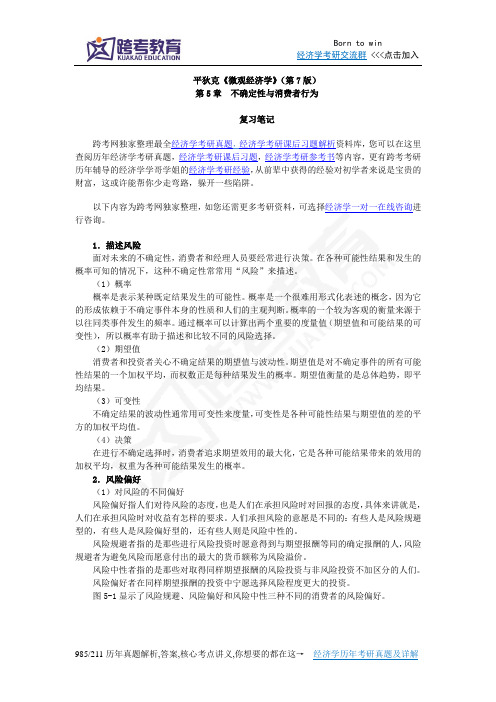
平狄克《微观经济学》(第7版)第5章不确定性与消费者行为复习笔记跨考网独家整理最全经济学考研真题,经济学考研课后习题解析资料库,您可以在这里查阅历年经济学考研真题,经济学考研课后习题,经济学考研参考书等内容,更有跨考考研历年辅导的经济学学哥学姐的经济学考研经验,从前辈中获得的经验对初学者来说是宝贵的财富,这或许能帮你少走弯路,躲开一些陷阱。
以下内容为跨考网独家整理,如您还需更多考研资料,可选择经济学一对一在线咨询进行咨询。
1.描述风险面对未来的不确定性,消费者和经理人员要经常进行决策。
在各种可能性结果和发生的概率可知的情况下,这种不确定性常常用“风险”来描述。
(1)概率概率是表示某种既定结果发生的可能性。
概率是一个很难用形式化表述的概念,因为它的形成依赖于不确定事件本身的性质和人们的主观判断。
概率的一个较为客观的衡量来源于以往同类事件发生的频率。
通过概率可以计算出两个重要的度量值(期望值和可能结果的可变性),所以概率有助于描述和比较不同的风险选择。
(2)期望值消费者和投资者关心不确定结果的期望值与波动性。
期望值是对不确定事件的所有可能性结果的一个加权平均,而权数正是每种结果发生的概率。
期望值衡量的是总体趋势,即平均结果。
(3)可变性不确定结果的波动性通常用可变性来度量,可变性是各种可能性结果与期望值的差的平方的加权平均值。
(4)决策在进行不确定选择时,消费者追求期望效用的最大化,它是各种可能结果带来的效用的加权平均,权重为各种可能结果发生的概率。
2.风险偏好(1)对风险的不同偏好风险偏好指人们对待风险的态度,也是人们在承担风险时对回报的态度,具体来讲就是,人们在承担风险时对收益有怎样的要求。
人们承担风险的意愿是不同的:有些人是风险规避型的,有些人是风险偏好型的,还有些人则是风险中性的。
风险规避者指的是那些进行风险投资时愿意得到与期望报酬等同的确定报酬的人,风险规避者为避免风险而愿意付出的最大的货币额称为风险溢价。
《微观经济学》平狄克 第5章
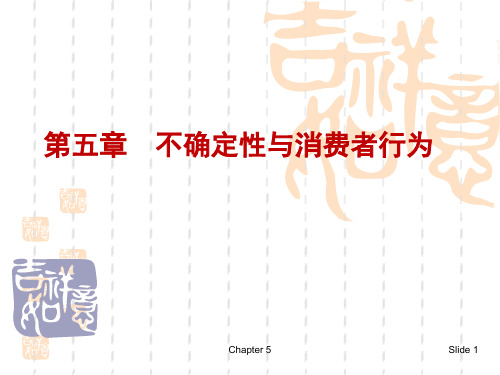
5.1 风险描述
方差:是各种可能结果与期望值的差的平方的加权
平均值。
方差=Pr1 ・[X1-E(x)]2 + Pr2 ・[X2-E(x)]2
标准差:方差的平方根
r E X Ex
2
2
2 2
P x1 r P2 x2 r ... Pn xn r 1
Slide 32
5.2 风险的偏好
效用
风险溢价
20 18
14
G
E
C F A
10
由于与期 望值为20 的不确定 收入所产 生的效用 为14的确 定性收入 为16,因 此,风险 溢价就是 4000美元 。
Slide 33
收入
0
10
16
20
Chapter 5
30
40
5.2 风险的偏好
预期收入的波动程度越大,风险溢价也就越高。
Chapter 5 Slide 6
5.1 风险描述
期望值(Expected Value) 期望值是对不确定事件的所有可能性结果的一 个加权平均。 权数是每一种可能性结果发生的概率。 期望值衡量的是总体趋势,即平均结果。
Chapter 5
Slide 7
5.1 风险描述
例如
投资海底石油开采项目:
如果天气较冷,空调的销售收入为6000,加热器的销售收入 为15000,预期收入为21000。
因此,通过多样化经营,天气无论炎热或较冷,厂商均可获 得21000的预期收入(固定收入),没有风险。
Chapter 5 Slide 40
5.3 降低风险
多样化
在上例中,加热器与空调是完全负相关的,厂商通 过多样化经营可以消除风险。 在通常的情况下,通过将投资分散在一些相关性较 小的事件上,可以较大程度地消除一部分风险。
平狄克《微观经济学》笔记和课后习题详解(竞争性市场分析)【圣才出品】

第9章竞争性市场分析9.1 复习笔记1.政府政策的损益评价——消费者剩余和生产者剩余消费者剩余和生产者剩余被用来评价消费者和生产者的损益。
将此方法用于分析天然气价格控制、航空管制、小麦价格支持计划和食糖配额时,可以发现损益可能相当大。
(1)消费者剩余和生产者剩余在无管制的竞争市场上,消费者和生产者按现行市价买卖商品。
但是,对于某些消费者来说,商品价值超过市场价格,他们愿意支付更高的价格。
消费者剩余是消费者获得的超过购买商品支付的总效益或总价值,等于需求曲线与市场价格之间的面积。
生产者剩余测度厂商在提供一定数量的某种产品时实际接受的总支付和愿意接受的最小总支付之间的差额,等于供给曲线与市场价格之间的面积。
总的来看,消费者剩余和生产者剩余测度竞争市场的福利效益。
(2)无谓损失价格控制导致总剩余的净损失,称之为无谓损失。
无谓损失是价格控制造成的低效率,其形成是因为生产者剩余的损失超过了消费者剩余的增加,或者是消费者剩余的损失超过了生产者剩余的增加。
由于政府政策通常将福利从一方转移给另一方,通常导致无谓损失,从而发生净损失。
在部分案例中,无谓损失较小,但有些案例,比如价格支持和进口配额,无谓损失较大。
无谓损失是一种经济低效率的形式,政府在设计和实施政策时必须加以考虑。
2.竞争性市场的效率(1)经济效率经济效率衡量经济主体利用经济资源的有效性。
高的经济效率表示对资源的充分利用或者能以最有效的生产方式进行生产;低的经济效率表示对资源的利用不充分或没有以最有效的方式进行生产。
(2)不同市场组织下的经济效率不同市场组织下的经济效率是不相同的,市场组织的类型直接影响经济效率的高低。
经济学家通过对不同市场条件下厂商的长期均衡状态的分析得出结论:完全竞争市场的经济效率最高,垄断竞争市场较高,寡头市场较低,垄断市场最低。
可见市场的竞争程度越高,则经济效率越高。
(3)政府干预竞争市场政府干预竞争市场并不总是坏事。
政府及政府所代表的社会,可能有经济效率以外的其他社会福利目标。
平狄克鲁宾费尔德微观经济学笔记
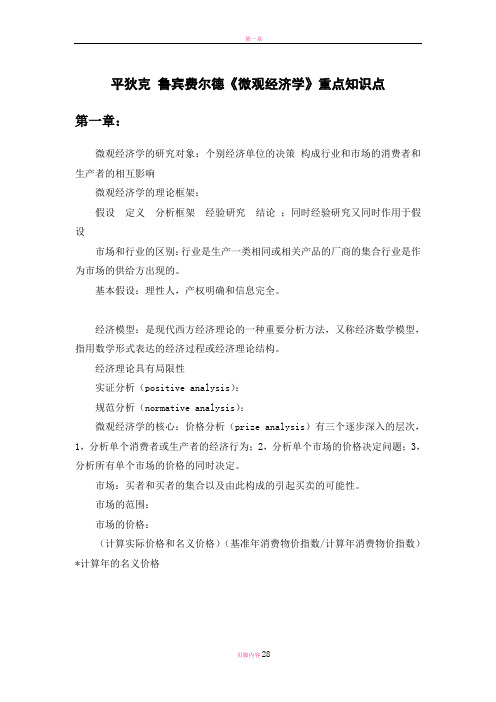
平狄克鲁宾费尔德《微观经济学》重点知识点第一章:微观经济学的研究对象:个别经济单位的决策构成行业和市场的消费者和生产者的相互影响微观经济学的理论框架:假设定义分析框架经验研究结论;同时经验研究又同时作用于假设市场和行业的区别:行业是生产一类相同或相关产品的厂商的集合行业是作为市场的供给方出现的。
基本假设:理性人,产权明确和信息完全。
经济模型:是现代西方经济理论的一种重要分析方法,又称经济数学模型,指用数学形式表达的经济过程或经济理论结构。
经济理论具有局限性实证分析(positive analysis):规范分析(normative analysis):微观经济学的核心:价格分析(prize analysis)有三个逐步深入的层次,1,分析单个消费者或生产者的经济行为;2,分析单个市场的价格决定问题;3,分析所有单个市场的价格的同时决定。
市场:买者和买者的集合以及由此构成的引起买卖的可能性。
市场的范围:市场的价格:(计算实际价格和名义价格)(基准年消费物价指数/计算年消费物价指数)*计算年的名义价格第二章:供给曲线:对于其他条件不变的情况下,对于市场上能够得到的价格生产者愿意出售的数量供给的变动是由非价格因素决定的其表现为整条曲线的移动(影响供给的有:相关原材料价格变化,技术变化,政策因素和自然因素)供给量的变动是由生产价格变动引起的,其表现为同一条曲线上点的移动需求曲线:对于其他条件不变的情况下,对于不同的价格水平下消费者愿意购买的数量。
需求的曲线是由非价格因素决定的,其表现为整条曲线的移动(影响需求的有:相关替代品的价格变化,消费者偏好,消费者收入和消费者对产品的价格预期)需求量的变动是由生产价格变动引起的,其表现为同一条曲线上点的移动市场的均衡出清,剩余市场机制总结:1,供给和需求相互作用,决定了市场达到均衡状态的价格水平,2,当市场偏离均衡时,市场会自动调整直到从新回到均衡,3,自由市场是市场机制有效的前提。
平狄克《微观经济学》习题——第5章不确定性与消费者行为
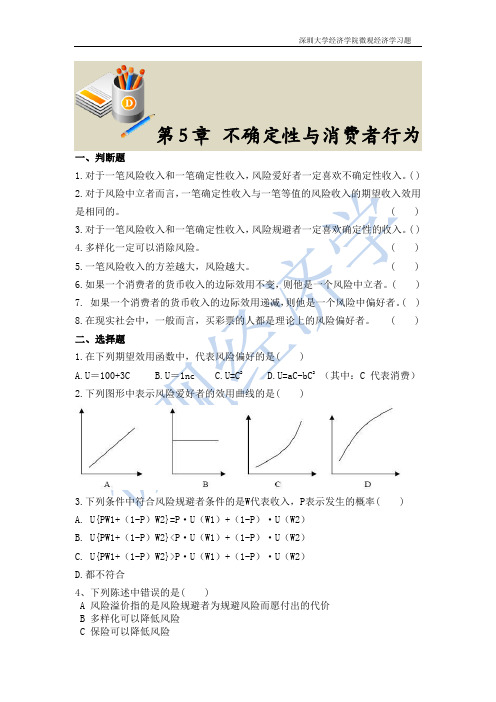
第5章不确定性与消费者行为一、判断题1.对于一笔风险收入和一笔确定性收入,风险爱好者一定喜欢不确定性收入。
( )2.对于风险中立者而言,一笔确定性收入与一笔等值的风险收入的期望收入效用是相同的。
( )3.对于一笔风险收入和一笔确定性收入,风险规避者一定喜欢确定性的收入。
( )4.多样化一定可以消除风险。
( )5.一笔风险收入的方差越大,风险越大。
( )6.如果一个消费者的货币收入的边际效用不变,则他是一个风险中立者。
( )7. 如果一个消费者的货币收入的边际效用递减,则他是一个风险中偏好者。
( )8.在现实社会中,一般而言,买彩票的人都是理论上的风险偏好者。
( )二、选择题1.在下列期望效用函数中,代表风险偏好的是( )A.U=100+3CB.U=1ncC.U=C2D.U=aC-bC2(其中:C 代表消费)2.下列图形中表示风险爱好者的效用曲线的是( )3.下列条件中符合风险规避者条件的是W代表收入,P表示发生的概率( )A. U{PW1+(1-P)W2}=P·U(W1)+(1-P)·U(W2)B. U{PW1+(1-P)W2}<P·U(W1)+(1-P)·U(W2)C. U{PW1+(1-P)W2}>P·U(W1)+(1-P)·U(W2)D.都不符合4、下列陈述中错误的是( )A 风险溢价指的是风险规避者为规避风险而愿付出的代价B 多样化可以降低风险C 保险可以降低风险D 获取更多的信息不能降低风险5.甲拥有一个可以获取一笔期望收入为100元的彩票,他最低愿意以80元价格卖出这个彩票。
下列说法错误的是( )A.风险溢价为20元 B.100元和80元给甲带来的效用相同C.乙最多愿意出100元卖这个彩票,则乙是个风险中性者D.没有人出100元以上的价格购买这个彩票三、计算题1. 一个消费者的财富为100万,效用函数为U=W1/2。
{财务管理财务知识}平狄克鲁宾费尔德微观经济学笔记

{财务管理财务知识}平狄克鲁宾费尔德微观经济学笔记平狄克鲁宾费尔德《微观经济学》重点知识点第一章:微观经济学的研究对象:个别经济单位的决策构成行业和市场的消费者和生产者的相互影响微观经济学的理论框架:假设定义分析框架经验研究结论;同时经验研究又同时作用于假设市场和行业的区别:行业是生产一类相同或相关产品的厂商的集合行业是作为市场的供给方出现的。
基本假设:理性人,产权明确和信息完全。
经济模型:是现代西方经济理论的一种重要分析方法,又称经济数学模型,指用数学形式表达的经济过程或经济理论结构。
经济理论具有局限性实证分析(positiveanalysis):规范分析(normativeanalysis):微观经济学的核心:价格分析(prizeanalysis)有三个逐步深入的层次,1,分析单个消费者或生产者的经济行为;2,分析单个市场的价格决定问题;3,分析所有单个市场的价格的同时决定。
市场:买者和买者的集合以及由此构成的引起买卖的可能性。
市场的范围:市场的价格:(计算实际价格和名义价格)(基准年消费物价指数/计算年消费物价指数)*计算年的名义价格第二章:供给曲线:对于其他条件不变的情况下,对于市场上能够得到的价格生产者愿意出售的数量供给的变动是由非价格因素决定的其表现为整条曲线的移动(影响供给的有:相关原材料价格变化,技术变化,政策因素和自然因素)供给量的变动是由生产价格变动引起的,其表现为同一条曲线上点的移动需求曲线:对于其他条件不变的情况下,对于不同的价格水平下消费者愿意购买的数量。
需求的曲线是由非价格因素决定的,其表现为整条曲线的移动(影响需求的有:相关替代品的价格变化,消费者偏好,消费者收入和消费者对产品的价格预期)需求量的变动是由生产价格变动引起的,其表现为同一条曲线上点的移动市场的均衡出清,剩余市场机制总结:1,供给和需求相互作用,决定了市场达到均衡状态的价格水平,2,当市场偏离均衡时,市场会自动调整直到从新回到均衡,3,自由市场是市场机制有效的前提。
(中文版)平狄克《微观经济学》全部课后答案
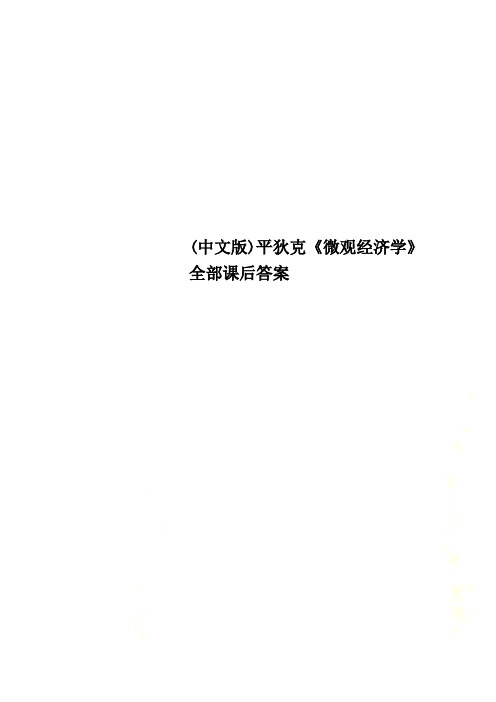
(中文版)平狄克《微观经济学》全部课后答案第一章复习题1.市场是通过相互作用决定一种或一系列产品价格的买卖双方的集合,因此可以把市场看作决定价格的场所。
行业是出售相同的或紧密相关的产品的厂商的集合,一个市场可以包括许多行业。
2.评价一个理论有两个步骤:首先,需要检验这个理论假设的合理性;第二,把该理论的预测和事实相比较以此来验证它。
如果一个理论无法被检验的话,它将不会被接受。
因此,它对我们理解现实情况没有任何帮助。
3.实证分析解释“是什么”的问题,而规范分析解释的是“应该是什么”的问题。
对供给的限制将改变市场的均衡。
A中包括两种分析,批评这是一种“失败的政策”——是规范分析,批评其破坏了市场的竞争性——是实证分析。
B向我们说明在燃油的配给制下总社会福利的被损坏——是实证分析。
4.由于两个市场在空间上是分离的,商品在两地间的运输是套利实现的条件。
如果运输成本为零,则可以在Oklahoma购买汽油,到New Jersey出售,赚取差价;如果这个差价无法弥补运输成本则不存在套利机会。
5.商品和服务的数量与价格由供求关系决定。
鸡蛋的实际价格从1970年至1985年的下降,一方面是由于人们健康意识的提高而导致鸡蛋需求的减少,同时也因为生产成本的降低。
在这两种因素下,鸡蛋的价格下降了。
大学教育的实际价格的升高,是由于越来越多的人倾向于获得大学教育而导致需求提高,同时教育的成本也在升高。
在这两方面因素作用下,大学教育费用提高了。
6.日圆相对美圆来说,价值升高,升值前相比,兑换同样数量的日圆需要付出更多的美圆。
由汇率的变化引起购买力的变化,在日本市场出售的美国汽车,由于美圆贬值日圆升值,持有日圆的消费者将较以前支付较底的价格;而在美国市场出售的日本汽车,由于日圆升值美圆贬值,持有美圆的消费者将面对较以前提高的价格。
4.长期弹性和短期弹性区别在于消费者对价格变化的反映速度以及可获得的替代品。
对纸巾这样的非耐用品,价格上升,消费者在短期内的反映很小。
- 1、下载文档前请自行甄别文档内容的完整性,平台不提供额外的编辑、内容补充、找答案等附加服务。
- 2、"仅部分预览"的文档,不可在线预览部分如存在完整性等问题,可反馈申请退款(可完整预览的文档不适用该条件!)。
- 3、如文档侵犯您的权益,请联系客服反馈,我们会尽快为您处理(人工客服工作时间:9:00-18:30)。
CHAPTER 6PRODUCTIONTEACHING NOTESChapter 6 is the first of the three chapters that present the basic theory of supply. It may be beneficial to first review, or summarize, the derivation of demand and present an overview of the theory of competitive supply. The review can be beneficial given the similarities between the theory of demand and the theory of supply. Students often find that the theory of supply is easier to understand because it is less abstract, and the concepts are more familiar. This in turn can improve the students’ understanding of the theory of demand when they go back and review it again.In this chapter it is important to take the time to carefully go through the definitions, as this will be the foundation for what is done in the next two chapters. While the concept of a production function is not difficult, the mathematical and graphical representation can sometimes be confusing. It helps to take the time to do as many examples as you have time for. When describing and graphing the production function with output on the vertical axis and one input on the horizontal axis, point out that the production function is the equation for the boundary of the production set, and hence defines the highest level of output for any given level of inputs. Technical efficiency is assumed throughout the discussion of the theory of supply. At any time you can introduce a discussion of the importance of improving productivity and the concept of learning by doing. Examples 1 and 2 in the text are also good for discussion.Graphing the production function leads naturally to a discussion of marginal product and diminishing returns. Emphasize that diminishing returns exist because some factors are fixed by definition, and that diminishing returns does not mean negative returns. If you have not discussed marginal utility, now is the time to make sure that the student knows the difference between average and marginal. An example that captures students’ attention is the relationship between average a nd marginal test scores. If their latest mid-term grade is greater than their average grade to date, this will increase their average.Isoquants are defined and discussed in section 6.3 of the chapter. Rely on the students’ understanding of indifference curves when discussing isoquants, and point out that as with indifference curves, isoquants are a two-dimensional representation of a three-dimensional production function. Key concepts in this section of the chapter are the marginal rate of technical substitution and returns to scale. Do as many concrete examples as you have time for to help explain these two important concepts. Examples 6.3 and 6.4 help to give concrete meaning to MRTS and returns to scale. Section 6.4 discusses returns to scale.QUESTIONS FOR REVIEW1. What is a production function? How does a long-run production function differ from a short-run production function?A production function represents how inputs are transformed into outputs by a firm.We focus on the firm with one output and aggregate all inputs or factors of productioninto one of several categories, such as labor, capital, and materials. In the short run,one or more factors of production cannot be changed. As time goes by, the firm has theopportunity to change the levels of all inputs. In the long-run production function, allinputs are variable.2. Why is the marginal product of labor likely to increase initially in the short run as more of the variable input is hired?The marginal product of labor is likely to increase initially because when there aremore workers, each is able to specialize on an aspect of the production process inwhich he or she is particularly skilled. For example, think of the typical fast foodrestaurant. If there is only one worker, he will need to prepare the burgers, fries,and sodas, as well as take the orders. Only so many customers can be served in anhour. With two or three workers, each is able to specialize and the marginal product(number of customers served per hour) is likely to increase as we move from one totwo to three workers. Eventually, there will be enough workers and there will be nomore gains from specialization. At this point, the marginal product will diminish.3. Why does production eventually experience diminishing marginal returns to labor in the short run?The marginal product of labor will eventually diminish because there will be at leastone fixed factor of production, such as capital. With capital fixed, the workplace willeventually become so congested, that the productivity of additional workers willdecline. Also, with capital fixed, as more workers are added, they will need to sharethe fixed capital, which will eventually cause the marginal product of labor todiminish as the capital is spread across too many workers. Think for example of anoffice where there are only three computers. As more and more employees mustshare the computers, the marginal product of each additional employee will diminish.4. You are an employer seeking to fill a vacant position on an assembly line. Are you more concerned with the average product of labor or the marginal product of labor for the last person hired? If you observe that your average product is just beginning to decline, should you hire any more workers? What does this situation imply about the marginal product of your last worker hired?In filling a vacant position, you should be concerned with the marginal product of thelast worker hired because the marginal product measures the effect on output, or totalproduct, of hiring another worker. This in turn will help to determine the revenuegenerated by hiring another worker, which can then be compared to the cost of hiringanother worker.The point at which the average product begins to decline is the point where averageproduct is equal to marginal product. When average product declines, the marginalproduct of the last worker hired is lower than the average product of previously hiredworkers.Although adding more workers results in a further decline in average product, totalproduct continues to increase, so it may still be advantageous to hire another worker.5. What is the difference between a production function and an isoquant?A production function describes the maximum output that can be achieved with anygiven combination of inputs. An isoquant identifies all of the different combinationsof the inputs that can be used to produce one particular level of output.6. Faced with constantly changing conditions, why would a firm ever keep any factors fixed? What criteria determine whether a factor is fixed or variable?Whether a factor is fixed or variable depends on the time horizon in consideration: allfactors are fixed in the very short run; all factors are variable in the long run. Asstated in the text: “All fixed inputs in the short run represent outcomes of previouslong-run decisions based on firms’ estimates of what they could profitably produce andsell.” Some factors are fixed in the short run, whether the firm likes it or not, simplybecause it takes time to adjust the level of the variables. For example, the firm may belegally bound by a lease on a building, some employees may have contracts that mustbe upheld, or construction of a new facility may take some number of months. Recallthat the short run is not defined as a specific number of months or years, but as thatperiod of time where some inputs cannot be changed for reasons such as those givenabove.7. Isoquants can be convex, linear, or L-shaped. What does each of these shapes tell you about the nature of the production function? What does each of these shapes tell you about the MRTS?Convex isoquants imply that within some range, some number of units of one inputcan be substituted for a unit of the other input, and output can be maintained at thesame level. In this case, the MRTS is diminishing as we move down along theisoquant. Linear isoquants imply that the slope, or the MRTS, is constant. Thismeans that the same number of units of one input can always be exchanged for a unitof the other input and output can be maintained. The inputs are perfect substitutes.L-shaped isoquants imply that the inputs are perfect complements, or that the firm isproducing under a fixed proportions type of technology. In this case the firm cannotgive up one input in exchange for the other and still maintain the same level ofoutput. For example, the firm may require exactly 4 units of capital for each unit oflabor, in which case one input cannot be substituted for the other.8. Can an isoquant ever slope upwards? Explain.No. This would mean that if you increased both inputs then output would stay thesame. As a general rule, if the firm has more of all the inputs they can produce moreoutput.9. Explain the term “marginal rate of technical substitution”? What does a MRTS=4 mean?MRTS is the amount by which the quantity of one input can be reduced when theother input is increased by one unit, while maintaining the same level of output. Ifthe MRTS is 4 then the one input can be reduced by 4 units as the other is increasedby one unit and output will be the same.10. Explain why the marginal rate of technical substitution is likely to diminish as more and more labor is substituted for capital.As the quantities of the inputs are changed the marginal product of each input willchange. As more and more labor is added, the marginal product of labor is likely todiminish. Because capital has been reduced, each unit of capital remaining is likelyto be more productive. Therefore, more units of labor will be required to replace eachunit of capital. Alternatively, as we move down and to the right along an isoquantalong which the MRTS is diminishing, we have to give up less capital for each unit oflabor added to keep output constant.11. Diminishing returns to a single factor of production and constant returns to scale are not inconsistent. Discuss.Diminishing returns to a single factor are observable in all production processes atsome level of inputs. This fact is so pervasive that economists have named it the “lawof diminishing marginal productivity.” By definition, the marginal product of an inputis the additional output generated by employing one more unit of the input, all otherinputs held fixed. The extra output, or returns, to the single input diminish because allother inputs are held fixed. For example, when holding the level of capital constant,each additional unit of labor has less capital to work with.Unlike the returns to a single factor, returns to scale are proportional increases in allinputs. While each factor by itself exhibits diminishing returns, output may more thandouble, less than double, or exactly double when all the inputs are doubled. Thedistinction again is that with returns to scale, all inputs are increased in the sameproportion and no input is held fixed.12. Can a firm have a production function that exhibits increasing returns to scale, constant returns to scale, and decreasing returns to scale as output increases? Discuss.Most firms have production functions that exhibit first increasing, then constant, andultimately decreasing returns to scale. At low levels of output, a proportional increasein all inputs may lead to a larger-than-proportional increase in output, based on anincrease in the opportunity for each factor to specialize. For example, if there are nowtwo people and two computers, each person can specialize by completing those tasksthat they are best at, which allows output to more than double. As the firm grows, theopportunities for specialization may diminish and a doubling of all inputs will lead toonly a doubling of output. When there are constant returns to scale, the firm isreplicating what it is already doing. At some level of production, the firm will be solarge that when inputs are doubled, output will less than double, a situation that canarise from management diseconomies.13. Give an example of a production process in which the short run involves a day or a week and the long run any period longer than a week.Any small business where one input requires more than a week to change would be anexample. The process of hiring more labor, which requires announcing the positi on,interviewing applicants, and negotiating terms of employment, can take a day, if donethrough a temporary employment agency. Usually, however, the process takes a weekor more. Expansion, requiring a larger location, will also take longer than a week.EXERCISES1. The menu at Joe’s coffee shop consists of a variety of coffee drinks, pastries, and sandwiches. The marginal product of an additional worker can be defined as the number of customers that can be served by that worker in a given time period. Joe has been employing one worker, but is considering hiring a second and a third. Explain why the marginal product of the second and third workers might be higher than the first. Why might you expect the marginal product of additional workers to eventually diminish?The marginal product could well increase for the second and third workers, sinceeach of the first 2 or 3 workers would be able to specialize in a different task. If thereis only 1 worker, then that worker will have to take orders and prepare all the food.Eventually, however, the marginal product would diminish because there would betoo many people behind the counter trying to accomplish a limited number of tasks.2. Suppose a chair manufacturer is producing in the short run (with its existing plant and equipment). The manufacturer has observed the following levels of production corresponding to different numbers of workers:Number of chairs Number of workers1 102 183 244 285 306 28725a. Calculate the marginal and average product of labor for this production function.The average product of labor, AP L, is equal to QL. The marginal product of labor, MP L,is equal to ∆∆QL, the change in output divided by the change in labor input. For thisproduction process we have:L Q AP L MP L0 0 __ __1 10 10 102 18 9 83 24 8 64 28 7 45 306 26 28 4.7 -27 25 3.6 -3b. Does this production function exhibit diminishing returns to labor? Explain.This production process exhibits diminishing returns to labor. The marginal product oflabor, the extra output produced by each additional worker, diminishes as workers areadded, and is actually negative for the sixth and seventh workers.c. Explain intuitively what might cause the marginal product of labor to becomenegative.Labor’s negative marginal product for L> 5 may arise from congestion in the chairmanufacturer’s facto ry. Since more laborers are using the same, fixed amount ofcapital, it is possible that they could get in each other’s way, decreasing efficiency andthe amount of output. Many firms also have to control the quality of output and thehigh congestion of labor may produce output that is not of a high enough quality to beoffered for sale, which can contribute to a negative marginal product.3. Fill in the gaps in the table below.Quantity of Variable InputTotalOutputMarginal Productof Variable InputAverage Productof Variable Input0 0 ___ ___1 2252 3003 3004 11405 2256 225Quantity of Variable InputTotalOutputMarginal Productof Variable InputAverage Productof Variable Input0 0 ___ ___1 225 225 2252 600 375 3003 900 300 3004 1140 240 2855 1365 225 2736 1350 -15 2254. A political campaign manager has to decide whether to emphasize television advertisements or letters to potential voters in a reelection campaign. Describe the production function for campaign votes. How might information about this function (such as the shape of the isoquants) help the campaign manager to plan strategy?The output of concern to the campaign manager is the number of votes. Theproduction function uses two inputs, television advertising and direct mail. The use ofthese inputs requires knowledge of the substitution possibilities between them. If theinputs are perfect substitutes, the resultant isoquants are line segments, and thecampaign manager will use only one input based on the relative prices. If the inputsare not perfect substitutes, the isoquants will have a convex shape. The campaignmanager will then use a combination of the two inputs.5. For each of the following examples, draw a representative isoquant. What can you say about the marginal rate of technical substitution in each case?a. A firm can hire only full-time employees to produce its output, or it can hire somecombination of full-time and part-time employees. For each full-time worker let go, the firm must hire an increasing number of temporary employees to maintain the same level of output.Place part time workers on the vertical axis$ and full time workers on the$horizontal axis. The slope of the isoquant measures the number of part timeworkers that can be exchanged for a full time worker, while still maintaining output.When we are at the bottom end of the isoquant we have a lot of full time workers andfew part time workers. As we move up the isoquant and give up full time workers,we must hire more and more part time workers to replace each full time worker. Theslope increases (in absolute value terms) as we move up the isoquant. The isoquantis therefore convex and we have diminishing marginal rate of technical substitution.b. A firm finds they it can always trade two units of labor for one unit of capital andstill keep output constant.The marginal rate of technical substitution measures the number of units of laborthat can be exchanged for a unit of capital while still maintaining output. If the firmcan always trade two labor for one capital then the MRTS is constant and theisoquant is linear.c. A firm requires exactly two full-time workers to operate each piece of machineryin the factory.This firm operates under a fixed proportions technology, and the isoquants are L-shaped. The firm cannot exchange any labor for capital and still maintain outputbecause it must maintain a fixed 2:1 ratio of labor:capital.6. A firm has a production process in which the inputs to production are perfectly substitutable in the long run. Can you tell whether the marginal rate of technical substitution is high or low, or is further information necessary? Discuss.The marginal rate of technical substitution, MRTS, is the absolute value of the slope ofan isoquant. If the inputs are perfect substitutes, the isoquants will be linear. Tocalculate the slope of the isoquant, and hence the MRTS , we need to know the rate atwhich one input may be substituted for the other. In this case, we do not knowwhether the MRTS is high or low. All we know is that it is a constant number. Weneed to know the marginal product of each input to determine the MRTS.7. The marginal product of labor in the production of computer chips is 50 chips per hour. The marginal rate of technical substitution of hours of labor for hours of machine-capital is 1/4. What is the marginal product of capital?The marginal rate of technical substitution is defined at the ratio of the two marginalproducts. Here, we are given the marginal product of labor and the marginal rate oftechnical substitution. To determine the marginal product of capital, substitute thegiven values for the marginal product of labor and the marginal rate of technical substitution into the following formula:M P M P M R T S ,M P L K K== o r 5014, or MP K = 200 computer chips per hour.8. Do the following functions exhibit increasing, constant, or decreasing returns to scale? What happens to the marginal product of each individual factor as that factor is increased, and the other factor is held constant?a. q =3L +2KThis function exhibits constant returns to scale. For example, if L is 2 and K is 2then q is 10. If L is 4 and K is 4 then q is 20. When the inputs are doubled, outputwill double. Each marginal product is constant for this production function. When Lincreases by 1 q will increase by 3. When K increases by 1 q will increase by 2.b. q =(2L +2K )12This function exhibits decreasing returns to scale. For example, if L is 2 and K is 2then q is 2.8. If L is 4 and K is 4 then q is 4. When the inputs are doubled, outputwill less than double. The marginal product of each input is decreasing. This can bedetermined using calculus by differentiating the production function with respect toeither input, while holding the other input constant. For examplegf the marginal product of labor is∂q∂L =22(2L +2K )12.Since L is in the denominator, as L gets bigger, the marginal product gets smaller. Ifyou do not know calculus, then you can choose several values for L, find q (for somefixed value of K), and then find the marginal product. For example, if L=4 and K=4then q=4. If L=5 and K=4 then q=4.24. If L=6 and K=4 then q= 4.47. Marginalproduct of labor falls from 0.24 to 0.23.c. q =3LK 2This function exhibits increasing returns to scale. For example, if L is 2 and K is 2then q is 24. If L is 4 and K is 4 then q is 192. When the inputs are doubled, outputwill more than double. Notice also that if we increase each input by the same factor λ then we get the following:q'=3(λL)(λK)2=λ33LK2=λ3q.Since λ is raised to a power greater than 1, we have increasing returns to scale.The marginal product of labor is constant and the marginal product of capital is increasing. For any given value of K, when L is increased by 1 unit, q will go up by 3K2 units, which is a constant number. Using calculus, the marginal product of capital is MPK=2*3*L*K. As K increases, MPK will increase. If you do not know calculus then you can fix the value of L, choose a starting value for K, and find q. Now increase K by 1 unit and find the new q. Do this a few more times and you can calculate marginal product. This was done in part b above, and is done in part d below.d.q=L 12K12This function exhibits constant returns to scale. For example, if L is 2 and K is 2 then q is 2. If L is 4 and K is 4 then q is 4. When the inputs are doubled, output will exactly double. Notice also that if we increase each input by the same factor λ then we get the following:q'=(λL)12(λK)12=λL12K12=λq.Since λ is raised to the power 1, we have constant returns to scale.The marginal product of labor is decreasing and the marginal product of capital is decreasing. Using calculus, the marginal product of capital isMPK=L122K12.For any given value of L, as K increases, MPK will increase. If you do not know calculus then you can fix the value of L, choose a starting value for K, and find q. Let L=4 for example. If K is 4 then q is 4, if K is 5 then q is 4.47, and if K is 6 then q is 4.89. The marginal product of the 5th unit of K is 4.47-4=0.47, and the marginal product of the 6th unit of K is 4.89-4.47=0.42. Hence we have diminishing marginal product of capital. You can do the same thing for the marginal product of labor.e.q=4L 12+4KThis function exhibits decreasing returns to scale. For example, if L is 2 and K is 2 then q is 13.66. If L is 4 and K is 4 then q is 24. When the inputs are doubled, output will less than double.The marginal product of labor is decreasing and the marginal product of capital is constant. For any given value of L, when K is increased by 1 unit, q will go up by 4 units, which is a constant number. To see that the marginal product of labor is decreasing, fix K=1 and choose values for L. If L=1 then q=8, if L=2 then q=9.65, and if L=3 then q=10.93. The marginal product of the second unit of labor is 9.65-8=1.65 and the marginal product of the third unit of labor is 10.93-9.65=1.28. Marginal product of labor is diminishing.9. The production function for the personal computers of DISK, Inc., is given byq = 10K0.5L0.5, where q is the number of computers produced per day, K is hours of machine time, and L is hours of labor input. DISK’s competitor, FLOPPY, Inc., is using the production function q = 10K0.6L0.4.a. If both companies use the same amounts of capital and labor, which will generatemore output?Let Q be the output of DISK, Inc., q2, be the output of FLOPPY, Inc., and X be thesame equal amounts of capital and labor for the two firms. Then, according to theirproduction functions,q = 10X0.5X0.5 = 10X(0.5 + 0.5) = 10Xandq2 = 10X0.6X0.4 = 10X(0.6 + 0.4) = 10X.Because q = q2, both firms generate the same output with the same inputs. Note that ifthe two firms both used the same amount of capital and the same amount of labor, butthe amount of capital was not equal to the amount of labor, then the two firms wouldnot produce the same level of output. In fact, if K>L then q2>q.b. Assume that capital is limited to 9 machine hours but labor is unlimited in supply. Inwhich company is the marginal product of labor greater? Explain.With capital limited to 9 machine units, the production functions become q = 30L0.5 andq2= 37.372L0.4. To determine the production function with the highest marginalproductivity of labor, consider the following table:L qFirm 1MP LFirm 1qFirm 2MP LFirm 20 0.0 ___ 0.00 ___1 30.00 30.00 37.37 37.372 42.43 12.43 49.31 11.943 51.96 9.53 58.00 8.694 60.00 8.04 65.07 7.07For each unit of labor above 1, the marginal productivity of labor is greater for the firstfirm, DISK, Inc.10. In Example 6.3, wheat is produced according to the production functionq = 100K0.8L0.2.a. Beginning with a capital input of 4 and a labor input of 49, show that the marginalproduct of labor and the marginal product of capital are both decreasing.For fixed labor and variable capital:K = 4 ⇒q = (100)(40.8 )(490.2 ) = 660.22K = 5 ⇒q = (100)(50.8 )(490.2 ) = 789.25 ⇒MP K = 129.03K = 6 ⇒q = (100)(60.8 )(490.2 ) = 913.19 ⇒MP K = 123.94K = 7 ⇒q = (100)(70.8 )(490.2 ) = 1,033.04 ⇒MP K = 119.85.For fixed capital and variable labor:L = 49 ⇒q = (100)(40.8 )(490.2 ) = 660.22L = 50 ⇒q = (100)(40.8 )(500.2 ) = 662.89 ⇒MP L = 2.67L = 51 ⇒q = (100)(40.8 )(510.2 ) = 665.52 ⇒MP L = 2.63L = 52 ⇒q = (100)(40.8 )(520.2 ) = 668.11 ⇒MP L = 2.59.Notice that the marginal products of both capital and labor are decreasing as thevariable input increases.b. Does this production function exhibit increasing, decreasing, or constant returns toscale?Constant (increasing, decreasing) returns to scale imply that proportionate increases ininputs lead to the same (more than, less than) proportionate increases in output. If wewere to increase labor and capital by the same proportionate amount (λ) in thisproduction function, output would change by the same proportionate amount:λq = 100(λK)0.8 (λL)0.2, orλq = 100K0.8 L0.2 λ(0.8 + 0.2) = qλTherefore, this production function exhibits constant returns to scale.。
